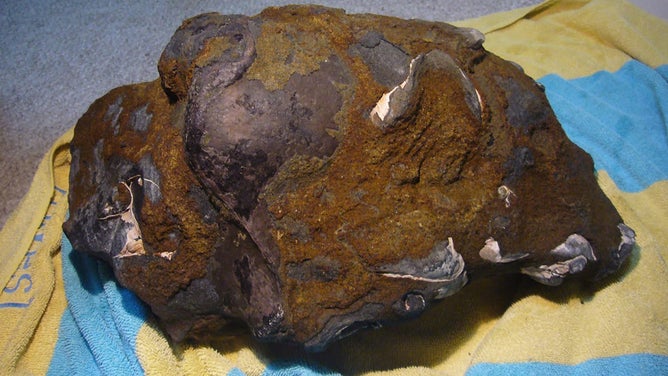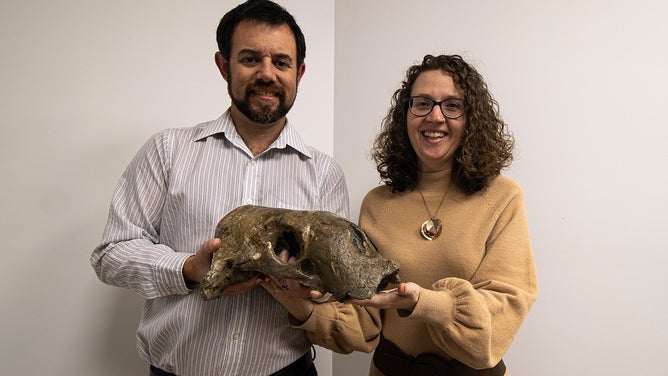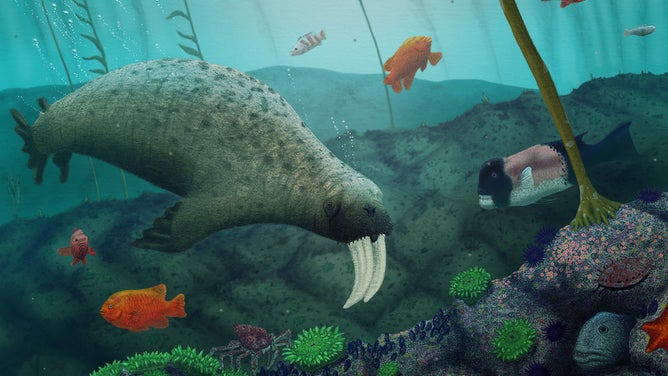New walrus species named after teen who discovered 5 million-year-old fossil
Forrest Sheperd, who is now in medical school, was partaking in one of his favorite pastimes on Jan. 21, 2011, when he made the amazing find.

FILE - A photo of Forrest Sheperd walking along the same beach six months after he made the walrus skull discovery.
(Forrest Sheperd)
A 13-year-old fossil hunter made a miraculous discovery of a fossilized walrus skull on the beaches near Santa Cruz, California, in 2011.
Now, 13 years later, the walrus to which that fossilized skull belonged was officially recognized as a new species, and it was named after the teen (now adult) who found it.
Forrest Sheperd, who is now in medical school, was partaking in one of his favorite pastimes on Jan. 21, 2011, when he made the amazing find.
NEW ALIEN-FACED MULTI-LEGGED CREATURES FOUND IN JUNGLE

FILE - A photo of the skull a couple of days after it was found.
(Forrest Sheperd / LiveNOW from FOX)
"On the day it was found, I had seen enough fossils to recognize that this fossil bone was a skull," Sheperd told FOX TV Stations. "It had a smooth, curved shape to it which indicated the exposed portion was part of the cranium of a skull. It had fallen down onto the sand from the bluff in this one chunk (the boulder) and somehow managed to not get scuffed up at all."
Sheperd had been fossil hunting ever since he was nine and would often go on these excursions two to three times a week.
So when he found the skull, Sheperd knew he’d struck gold.
"I remember the adrenaline rush after realizing it was such a nice skull and the feeling that this was going to be an important find," he said.
The species of walrus Sheperd found was similar to another unique species of toothless walrus called the Valenictus chulavistensis, according to Robert Boessenecker, the Chief Paleontologist for the Charleston Center for Paleontology.
Boessenecker was also one of the people responsible for getting the species recognized, and he promised Sheperd he’d name the walrus after him.
SHARK FOSSILS FROM ALABAMA, KENTUCKY NATIONAL PARK LEAD TO DISCOVERY OF NEW SPECIES

Robert Boessenecker and Sarah Boessenecker holding the skull.
(Robert Boessenecker / LiveNOW from FOX)
The newest species is called Valenictus sheperdi (for Sheperd) and is described as being possibly larger than the Valenictus chulavistensis (another walrus species). It has a distinctive bony crest behind its tusks, Boessenecker explained to FOX.
"Both species of Valenictus are highly unusual in that the skull is toothless, aside from the tusks: tusks are canines, but the single pair of canines are the only teeth Valenictus has - all incisors, premolars, and molars are all lost. This is an adaptation for extreme suction feeding - modern walruses don't chew clams, they just suck the meat right out of the shell - but still use the teeth for communication by clacking them together. Valenictus was even more specialized than the modern walrus at suction feeding for clams," Boessenecker added.
SEE THE ASTEROID SAMPLE A NASA SPACECRAFT TOOK 7 YEARS TO BRING BACK TO EARTH
The fossil that Sheperd found is roughly 5 million years old and weighed about 70 pounds including the rock it was fossilized in.
"It was all in one piece, undamaged, and extremely well-preserved" Sheperd said. "Even though I didn't know what animal the skull was from, I knew it was an extraordinary find and we had to get it off the beach one way or another."
FULL MOON BRINGS OUT 'UNICORN' IN ARIZONA NATIONAL PARK

FILE - This is what the skull looked like after Sheperd got it back home on the day it was found (Jan. 21, 2011). There is a ruler to give some scale. The darker, smoother surface is the bone emerging from the rock, which is harder than cement.
(Forrest Sheperd)
Sheperd said he was not alone the day he found the skull, and his friend, Dtrik Viehmann, was able to help him lift the heavy specimen and take it back to the family car.
"This was the first and only time he had gone with me, so I often told him he was good luck and I should take him more often," Sheperd joked.
The specimen had to be extracted from the block of rock it was fossilized in, which is one of the reasons why it took so long for the species to be identified and get its official name.
"We started writing the paper in 2019, and took three years to write the paper. We collected a lot of data, and some of this process was slowed down by COVID. The paper was also in review for over a year," Boessenecker explained.
NEW SPECIES OF ANCIENT SHARK IDENTIFIED AT NATIONAL PARK IN KENTUCKY

FILE - Artist depiction of what the Valenictus sheperdi would have looked like.
(Robert Boessenecker)
Sheperd said he was thrilled to have the new species named after him.
"I feel extremely grateful that the scientific community decided to recognize my contribution in such a meaningful way," Sheperd told FOX. "The fact that these professional paleontologists took the time to mentor me in my interest in science, identify all of my fossils, and provide ways for me to get involved in the scientific process is what allowed me to see a place for myself in a science-related field. It's a big part of why I got a degree in biology, and why I am in medical school today."
Sheperd said he had no plans to stop collecting fossils and would continue to indulge in his hobby – time permitting, of course.
This story was reported from Los Angeles.


